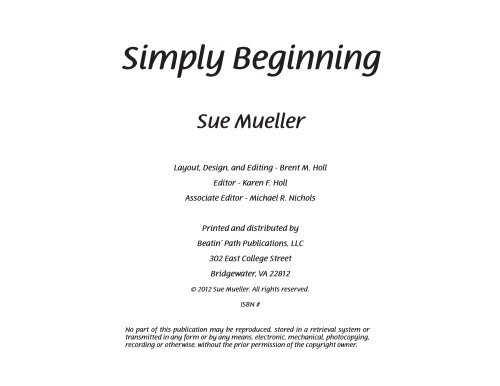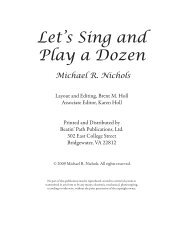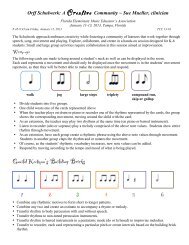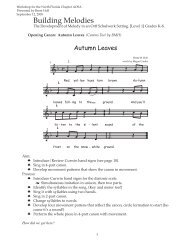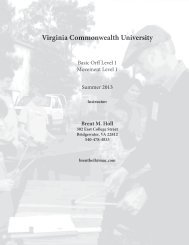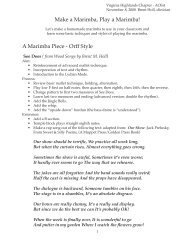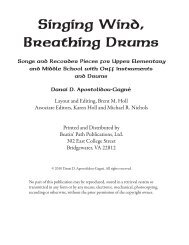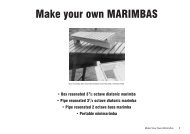Simply Beginning Sue Mueller - Beatin' Path Publications, LLC
Simply Beginning Sue Mueller - Beatin' Path Publications, LLC
Simply Beginning Sue Mueller - Beatin' Path Publications, LLC
You also want an ePaper? Increase the reach of your titles
YUMPU automatically turns print PDFs into web optimized ePapers that Google loves.
<strong>Simply</strong> <strong>Beginning</strong><br />
<strong>Sue</strong> <strong>Mueller</strong><br />
Layout, Design, and Editing - Brent M. Holl<br />
Editor - Karen F. Holl<br />
Associate Editor - Michael R. Nichols<br />
Printed and distributed by<br />
Beatin’ <strong>Path</strong> <strong>Publications</strong>, <strong>LLC</strong><br />
302 East College Street<br />
Bridgewater, VA 22812<br />
© 2012 <strong>Sue</strong> <strong>Mueller</strong>. All rights reserved.<br />
ISBN #<br />
No part of this publication may be reproduced, stored in a retrieval system or<br />
transmitted in any form or by any means, electronic, mechanical, photocopying,<br />
recording or otherwise, without the prior permission of the copyright owner.
<strong>Simply</strong> <strong>Beginning</strong>, an eclectic collection of kid-tested materials, can be used to introduce a new music concept or skill as you start<br />
or end a day, year, or season. I often found it difficult to find simple activities or songs to use when presenting new ideas to students<br />
and would then create my own to fit my students’ needs. Teaching Suggestions at the end of the book provide an in-depth conversation<br />
about prerequisite skills and preparation.<br />
The lessons are intended to be among the first lessons to teach a new skill or present a music concept but are not intended to be sequentially<br />
organized. Even though a grade level is suggested with the activities, you should make choices based on the needs of your<br />
students. Use music language in a song or activity to provide terms the students can use to describe the music elements of subsequent<br />
activities. There are musical terms listed in the Glossary appropriate to this book.<br />
As always, visuals and suggested processes are provided. Ideas for extending the activities are included, giving your students opportunity<br />
to change and manipulate the material. Each lesson process uses the Orff Schulwerk teaching model of Exploration, Imitation,<br />
Improvisation/Creation, and Literacy. Please do not stop at the imitation stage. Encourage your students to manipulate, change<br />
and use the elements of music to give voice to their ideas and creative thinking. It is not enough for students to simply recognize or<br />
identify a concept. Understanding how to use the concept in music-making is the ultimate goal. The Orff Schulwerk approach emphasizes<br />
this process.<br />
With careful planning and materials that can sustain many weeks of learning, you can use the Orff Schulwerk process to stimulate<br />
students’ exploration and improvisation. The activities presented in this book are just beginnings, I encourage you to experiment, extend<br />
and energize your favorite lessons using the ideas presented and students’ suggestions. Both you are your students will develop<br />
musicianship and find joy in the music you create.
Table of Contents<br />
Let’s Begin Begin the Day (Grades 4 - 6) 6<br />
It’s Time Begin the Day (Grades 5 - 6) 8<br />
Part of Me Begin Pulse and Phrase (Grades K - 1) 10<br />
Speak or Sing Begin Melody (Grades K - 1) 12<br />
Welcome to Music Begin Timbre (Grades 4 - 6) 14<br />
Instrument’s Own Sound Begin Timbre (Grades 3 - 5) 16<br />
‘Round and ‘Round Begin Form (Grades 1 - 2) 18<br />
Rondo Is a Simple Form Begin Form (Grades 2 - 4) 20<br />
Hello, Mr. Groundhog Begin Ostinato (Grades 2 - 4) 22<br />
One More Time Begin Layered Ostinati (Grades 3 - 5) 24<br />
Taxi, Taxi Begin the Bordun (Grades 1 - 2) 26<br />
Bullfrog’s Song Begin the Bordun (Grades 3 - 4) 28<br />
Bumblebee Begin Soprano Recorder (Grades 3 - 4) 30<br />
Traffic Jam Begin Soprano Recorder (Grades 4 - 5) 32<br />
Alto Is So E-C Begin Alto Recorder (Grades 5 - 6) 34<br />
Bubblegum, Bubblegum Begin Improvisation (Grades 4 - 6) 36<br />
Cookies Begin Improvisation (Grades 5 - 6) 38<br />
Come on Now, Let’s Celebrate Begin the New Year (Grades 5 - 6) 40<br />
Glossary 43<br />
Teaching Suggestions 44
Grade 5 - 6<br />
Let's Begin<br />
Let’s Begin<br />
Begin the Day<br />
1<br />
& # # 4 4 œ œ œ<br />
‰ j œ<br />
œ œ œ œ œ œ<br />
2<br />
œ œ œ ‰<br />
j<br />
œ<br />
<strong>Sue</strong> <strong>Mueller</strong><br />
œ œ œ œ œ Œ<br />
Let's be - gin the day with mu - sic mak - ing. With new friends, we'll sure - ly have some fun.<br />
5<br />
& # #<br />
œ<br />
3<br />
œ œ œ<br />
Let's Begin - Movement<br />
œ œ œ œ œ<br />
œ<br />
4<br />
œ œ œ œ œ œ œ œ<br />
œ œ œ<br />
Œ<br />
First we'll<br />
sing, then<br />
add a<br />
lit - tle move-ment.<br />
Clap your hands and stomp your feet and<br />
then you're done.<br />
Movement<br />
4 ˙ ˙<br />
˙<br />
˙<br />
Preview Only<br />
Please Don’t Copy<br />
œ œ œ œ<br />
œ œ œ œ<br />
5<br />
Side, close,<br />
œ<br />
œ œ<br />
œ<br />
do, sol, do', sol,<br />
side,<br />
close,<br />
œ œ œ œ<br />
apart, cross, apart, close,<br />
in, 2, 3, 4,<br />
œ œ œ œ œ œ<br />
out, 2, 3, 4,<br />
˙ ˙<br />
clap, clap, clap, stomp, stomp, stomp, bow, up.<br />
4
Aim<br />
Sing and move in 4-part canon. Show phrases through creative<br />
locomotor and non-locomotor movement. Begin the day.<br />
Anticipatory Set<br />
Students have prior experience singing and moving in canon.<br />
Exploration<br />
uu<br />
Students explore ways to move in a circle formation.<br />
uu<br />
Practice moving different ways in circle formation at students’<br />
Suggestions (in/out, forward/backward, individual/<br />
group, down/up, etc.).<br />
Imitation<br />
uu<br />
Teach song through echo process until secure.<br />
uu<br />
Practice singing in 2-part, then 4-part canon.<br />
Performance Suggestions<br />
uu<br />
Sing and move in unison.<br />
uu<br />
Sing and move in 4-part canon.<br />
uu<br />
Move in 4-part canon.<br />
uu<br />
Sing and move in 4-part canon.<br />
uu<br />
As each group finishes, repeat last phrase until all parts are<br />
finished.<br />
Extensions<br />
uu<br />
Play on barred instruments.<br />
uu<br />
Rearrange the melody, using retrograde, inversion. Change<br />
the words to fit another day, holiday, season, etc.<br />
uu<br />
Sing the song in another meter.<br />
uu<br />
Create and accompaniment using a I - V chord change and/<br />
or a melodic ostinato.<br />
Preview Only<br />
Please Don’t Copy<br />
Improvisation/Creation<br />
uu<br />
Students improvise movement to illustrate the text and<br />
length of each phrase.<br />
uu<br />
Students finalize movement to each phrase and practice in<br />
unison, 2-part, 4-part. Practice with and without singing.<br />
Literacy<br />
uu<br />
Notate movement creations.<br />
uu<br />
Movement notation can be created with devised notation<br />
or notated with note values as in score format.<br />
uu<br />
Identify the melodic sequences in melody. Students identify<br />
the melodic sequences easily when referring to solfege<br />
warm-up.<br />
5
I Can Feel the Phrase<br />
Grade K - 1<br />
Part of Me<br />
Begin Pulse and Phrase<br />
& b 4 2 œ œ œ œ<br />
œ<br />
œ<br />
œ<br />
œ<br />
œ<br />
<strong>Sue</strong> <strong>Mueller</strong><br />
Œ<br />
5<br />
& b<br />
I can feel the beat<br />
phrase<br />
right<br />
œ œ œ œ œ œ œ<br />
here<br />
œ<br />
you<br />
œ<br />
see.<br />
œ<br />
Œ<br />
Please Don’t Copy<br />
I can feel the<br />
Preview Only<br />
beat<br />
phrase<br />
'cause<br />
it's<br />
part<br />
of<br />
me.<br />
Aim<br />
Begin exploring the pulse and demonstrate phrase length through movement, body percussion and barred instrument exploration.<br />
Anticipatory Set<br />
Students have explored pulse for the length of a phrase.<br />
Exploration<br />
uu<br />
Teacher sings the song while students show pulse through locomotor and non-locomotor movement.<br />
uu<br />
Students explore keeping pulse on different parts of their body with both hands (bilateral movement).<br />
uu<br />
Students show pulse with scarf exploring high/low, in/out levels moving through space.<br />
Imitation<br />
uu<br />
Students learn song through echo process until secure.<br />
uu<br />
Students imitate teacher’s hand movements showing the phrase. Teacher shows phrase length while moving right to left and<br />
drawing an arch or “rainbow” in the air (mirror).<br />
6
Improvisation/Creation<br />
uu<br />
Students explore showing the phrase length with a scarf<br />
while singing.<br />
uu<br />
Students internalize each phrase after singing and show<br />
pulse to the length of the phrase with scarf dances. (see<br />
glossary)<br />
Literacy<br />
uu<br />
Students draw pulse using stick notation for each phrase.<br />
uu<br />
Students demonstrate understanding of phrase length and<br />
realizing each phrase contains the same number of beats.<br />
uu<br />
Ask a student to trace the shape of each phrase on the visual.<br />
Performance Suggestions<br />
uu<br />
Students internalize each phrase after singing and show the<br />
pulse to the length of the phrase with scarf dances.<br />
uu<br />
Divide class into players and dancers. Players are at the<br />
barred instruments, dancers are scattered in the space with<br />
uu<br />
uu<br />
Preview Only<br />
Please Don’t Copy<br />
scarves.<br />
Everyone sings song in unison one time without playing or<br />
moving.<br />
Everyone sings phrase one followed by the internalization of<br />
the phrase - players play any two notes in the C pentatonic<br />
scale on the pulse to the length of the phrase. Dancers move<br />
to the pulse with their scarves, showing the phrase length,<br />
stopping at the end of the phrase. Encourage dancers to<br />
interact while moving through space.<br />
non-tuned percussion.<br />
uu<br />
Students sing phrase one as a question and sing a melodic<br />
answer the length of the phrase. (Use sol - mi or sol - la - mi.)<br />
uu<br />
Students speak the length of the phrase using nonsense or<br />
made-up words. Let half the class speak the first phrase as<br />
a pretend question, and half the class an answer.<br />
uu<br />
Students use the question/answer approach to create new<br />
phrases given a theme.<br />
Example: Recess.<br />
Question, “Do you want to go outside to play”<br />
Answer, “Yes, I think I’ll jump rope with my friend.”<br />
uu<br />
Extend the question/answer approach to new questions and<br />
answers with new melodic rhythms, songs, phrase lengths,<br />
and meters.<br />
Extensions<br />
uu<br />
Students play pulse on barred instruments choosing a<br />
sequence of notes in the F pentatonic scale creating a new<br />
melody.<br />
uu<br />
Students sing phrase one as a question and respond with<br />
a rhythmic answer the same length on body percussion or<br />
7
Glossary<br />
Anticipatory Set is a brief activity or discussion at the beginning<br />
of the lesson that effectively engages students’ attention and focuses<br />
their thoughts on the learning objective.<br />
Articulation for soprano and alto recorder is the process of joining<br />
or separating the individual notes. See Teaching Suggestions.<br />
Two styles of articulation on the recorder easily achieved by<br />
young recorder players are:<br />
Simple Bordun Examples:<br />
& c œ œ<br />
Œ œ œ<br />
Œ<br />
&<br />
3<br />
Chord Bordun<br />
œ<br />
œ œ œ<br />
Crossover Bordun<br />
œ<br />
œ<br />
œ<br />
Broken Chord<br />
˙<br />
˙<br />
Level Bordun<br />
œ<br />
Preview Only<br />
Please Don’t Copy<br />
Legato the tongue starts and ends the note, connecting the end<br />
of the first note with the beginning of the next.<br />
Staccato The tongue starts and closes the notes in a very rapid<br />
manner, the quicker the tongue movement the shorter the note.<br />
Barred Instruments are a unique set of Xylophones, Metallophones,<br />
and Glockenspiels with ranges of 13 - 15 pitches, arranged<br />
in three pitch groupings, Bass, Alto, and Soprano. With Orff-style<br />
barred instruments, bars are removable.<br />
Body Instruments are sounds made with the hands and feet: snapping,<br />
clapping, patschen and stamping. Also called body percussion.<br />
Body Percussion utilizes the body as a percussion instrument.<br />
Typical body instruments in Orff Schulwerk include, but aren’t<br />
limited to, Snap (fingers), Clap (hands), Patschen (pat knees), and<br />
Stomp (feet).<br />
Bordun (Drone) The bordun is a single chord harmonic accompainment<br />
based on the tonic chord using a perfect fifth. The bordun is<br />
made up of the first and fifth degrees of the scale, where the tonic<br />
pitch must occur on every strong beat.<br />
Complementary Rhythms go together well and are interesting to<br />
the ear. The integrity of all parts is maintained.<br />
Curwen Hand Signs provide a physical action for a vocal pitch. Low<br />
do begins at waist level and ends with high do at eye level.<br />
Echo Process, or Imitation, starts when the teacher speaks the<br />
entire poem while students listen (usually keeping a pulse on the<br />
body). Teacher speaks the first phrase of the poem; students echo.<br />
Teacher speaks the first two phrases; students echo. Teacher speaks<br />
the entire poem; students echo. Repeat or remediate any part of the<br />
process until students can perform the entire piece independently.<br />
This process can be used for teaching poems, songs, rhythm patterns,<br />
and instrument parts.<br />
Exploration is a teaching tool in which learning of concepts takes<br />
place through experimentation with the elements of music. Often<br />
introduced with “What would happen if. ...” or “Can you do it in<br />
another way”<br />
Fingerplay is a word I use to indicate to students to finger the notes<br />
on recorder while speaking or singing words.<br />
8
<strong>Beginning</strong> the Day<br />
uu<br />
uu<br />
Teaching Suggestions<br />
Sing a song or a round/canon to start the day making music.<br />
Bring back a previously taught song or activity and use it to<br />
teach new material. Students are able to better understand<br />
the music elements when they know the activity well.<br />
Perform a previously taught body percussion piece to “wake<br />
them up”.<br />
Begin pulse<br />
uu<br />
uu<br />
uu<br />
uu<br />
uu<br />
uu<br />
uu<br />
Young students need to experience and feel the pulse in<br />
many ways, through movement, body percussion, playing<br />
tuned and non-tuned percussion, visualization (iconic representation,<br />
stick notation) and listening. Feeling the pulse<br />
is paramount to playing or reading.<br />
Discern between pulse and rhythmic patterns.<br />
Discern between showing the pulse and playing, speaking<br />
and singing to the pulse.<br />
Younger students sense of pulse is much quicker than an<br />
adult’s tempo. Observe what is natural for the student before<br />
imposing your tempo.<br />
Recognize pulse as being able to change (tempo) and gradually<br />
changing (accelerando and ritardando). Always keep the<br />
pulse steady when speaking poems, playing, or singing unless<br />
changes in tempo are part of the expression of the piece.<br />
Recognize the accented pulse which leads to the organization<br />
of pulse into metric groupings. This can be done through<br />
words, poems, and certainly movement exercises. Use the<br />
student’s name, spelling words for the week, musical terms,<br />
etc.<br />
Work with short ostinato patterns, combining them as students<br />
are able and maintain the pulse.<br />
Begin Phrase<br />
Preview Only<br />
Please Don’t Copy<br />
uu<br />
Understanding the length of a phrase best begins with movement<br />
and speech.<br />
uu<br />
Start with half phrases, then full phrases, much like teaching<br />
a song in chunks.<br />
••<br />
Walk (or other locomotor movement) a pathway to the<br />
length of a phrase of text or melody being spoken, sung,<br />
or played by teacher and or students.<br />
••<br />
Walk (or other locomotor movement) the length of a<br />
phrase away from partner, then back to a partner.<br />
••<br />
Show phrase length using creative movement with the aid<br />
of props (scarves, ribbon sticks, or whirley gigs).<br />
••<br />
Create movement with a partner showing the length of<br />
the phrase.<br />
••<br />
“Draw” the phrase length in the air using a pleasing visual<br />
shape.<br />
••<br />
Divide class into two groups positioned on opposite sides<br />
of the room or space. One group moves across the room<br />
or space to the other side for the length of a phrase. The<br />
second group moves across the room or space on the next<br />
phrase. Continue in this fashion while speaking a poem,<br />
singing a song, or listening to music.<br />
••<br />
Using a parachute, students move many ways to show<br />
phrase length.<br />
••<br />
In circle formation, students create ways to move, showing<br />
the length of phrase (around, backward, in/out, etc.)<br />
uu<br />
Students identify phrases that are the same or different in<br />
rhythm, melody and/or text. Provide many ways to show<br />
same or different.<br />
••<br />
Use hand signals or body percussion.<br />
••<br />
Sing or speak phrases antiphonally (between rows, girls/<br />
boys, solo/group, teacher/students). Girls could sing all<br />
the phrases that are the same, boys sing the phrases that<br />
are different.<br />
9


